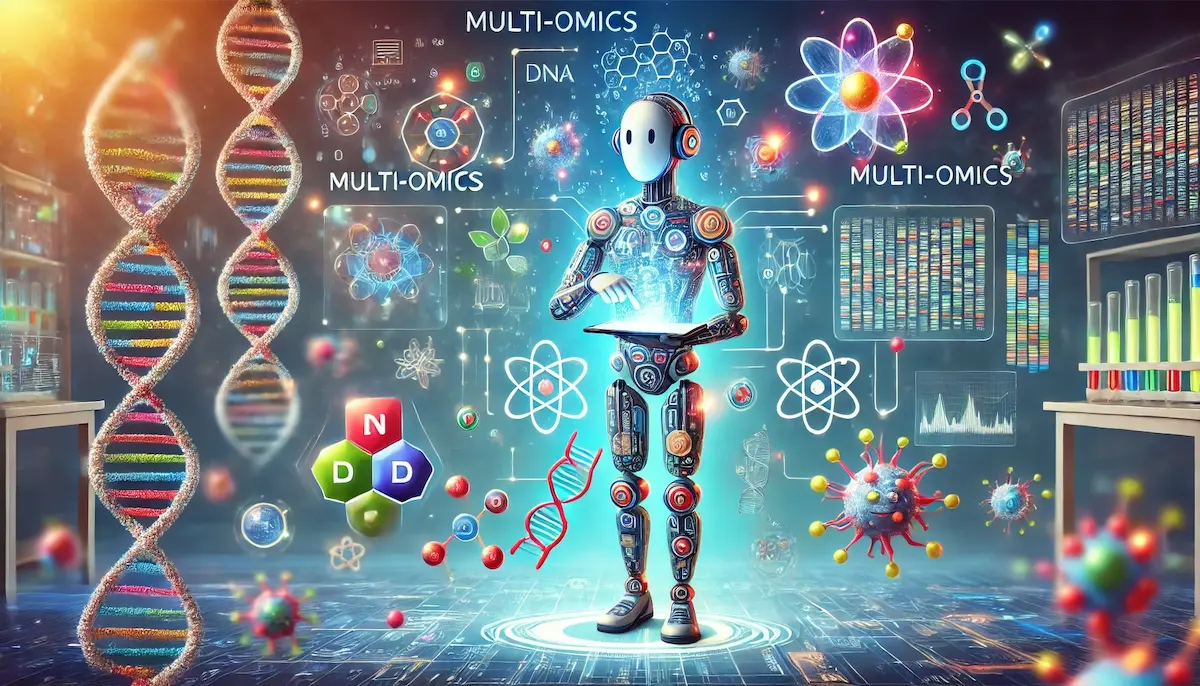Multi-omics is an integrated approach in biological research that combines data from multiple “omics” layers—such as genomics, transcriptomics, proteomics, metabolomics, and epigenomics—to provide a comprehensive view of the complex interactions and processes within a biological system. By analyzing these different types of molecular data together, multi-omics offers a more holistic understanding of how genes, proteins, metabolites, and other biomolecules work together to regulate cellular functions and influence health and disease.
The Basics of Multi-omics
Each “omics” field provides a different perspective on the molecular landscape of a cell or organism:
- Genomics: Focuses on the complete set of DNA in an organism, providing information about genetic variations, mutations, and overall genetic makeup.
- Transcriptomics: Analyzes the RNA transcripts produced by genes, offering insights into gene expression patterns and how genes are regulated.
- Proteomics: Studies the full set of proteins in a cell or tissue, revealing how proteins are produced, modified, and interact to carry out biological functions.
- Metabolomics: Examines the small molecules, or metabolites, within cells, tissues, or organisms, providing information about metabolic pathways and cellular processes.
- Epigenomics: Investigates the chemical modifications to DNA and histones that regulate gene expression without altering the underlying DNA sequence.
In a multi-omics study, data from two or more of these omics layers are collected and integrated to understand how different molecular processes are connected. This approach allows researchers to see how changes at one level (e.g., genetic mutations) influence other levels (e.g., protein expression or metabolic activity), leading to a more comprehensive understanding of biological systems.
Applications of Multi-omics
Multi-omics has a wide range of applications across various fields of research, including medicine, agriculture, and environmental science:
Precision Medicine
One of the most significant applications of multi-omics is in precision medicine, where it is used to tailor medical treatments to individual patients based on their unique molecular profiles. By integrating data from genomics, transcriptomics, proteomics, and metabolomics, researchers can identify biomarkers that predict a patient’s response to specific drugs or therapies. This allows for more personalized and effective treatment plans, particularly in complex diseases like cancer, where different patients may have distinct molecular subtypes of the same disease.
For example, in cancer research, multi-omics can reveal how genetic mutations influence protein expression and metabolic pathways, helping to identify vulnerabilities that can be targeted with specific therapies. This approach is also used in studying complex disorders like diabetes, cardiovascular disease, and neurodegenerative diseases, where multiple factors contribute to disease development and progression.
Drug Discovery and Development
Multi-omics is transforming drug discovery by providing a more detailed understanding of disease mechanisms. By studying the interactions between genes, proteins, and metabolites in disease states, researchers can identify new drug targets and develop therapies that more precisely target the underlying causes of disease. Multi-omics also helps in understanding the mechanisms of drug resistance and identifying potential biomarkers for monitoring treatment response.
Systems Biology
Multi-omics is central to systems biology, an approach that seeks to understand how biological systems function as a whole. By integrating data from multiple omics layers, systems biology aims to model the complex networks of interactions that govern cellular processes. This holistic view is essential for understanding how cells respond to environmental changes, how they maintain homeostasis, and how disruptions in these networks can lead to disease.
Agriculture and Crop Improvement
In agriculture, multi-omics is used to improve crop yields, enhance resistance to pests and diseases, and develop plants that are more tolerant to environmental stresses like drought or extreme temperatures. By integrating genomics, transcriptomics, proteomics, and metabolomics data, researchers can identify the molecular pathways that control important traits in crops and use this information to guide breeding programs and genetic engineering efforts.
Environmental Science
Multi-omics is also applied in environmental science to study the complex interactions between organisms and their environments. For example, in microbiome research, multi-omics helps to understand how microbial communities function in different ecosystems, such as soil, oceans, or the human gut. This knowledge is critical for developing strategies to protect biodiversity, manage ecosystems, and mitigate the impacts of climate change.
The Future of Multi-omics
The field of multi-omics is rapidly advancing, driven by improvements in sequencing technologies, mass spectrometry, and computational tools. As these technologies become more accessible and affordable, multi-omics studies are likely to become more common, providing deeper insights into the molecular basis of health and disease.
One exciting development in multi-omics is the integration of spatial information, known as spatial multi-omics. This approach combines multi-omics data with spatially resolved techniques, allowing researchers to see how molecular processes vary across different regions of a tissue or organ. This is particularly valuable in studying complex tissues like the brain or tumors, where different regions may have distinct molecular profiles.
Another promising area is the use of artificial intelligence and machine learning to analyze multi-omics data. These tools can help to identify patterns and relationships within large, complex datasets, leading to new discoveries and more accurate predictions of disease outcomes and treatment responses.
As multi-omics continues to evolve, it will play a crucial role in advancing our understanding of biology and medicine, paving the way for new diagnostic tools, therapies, and innovations in healthcare and beyond.
Blockfine thanks you for reading and hopes you found this article helpful.
